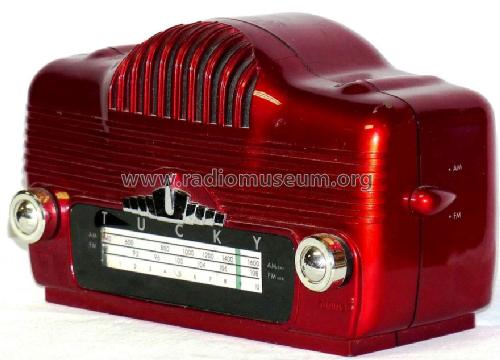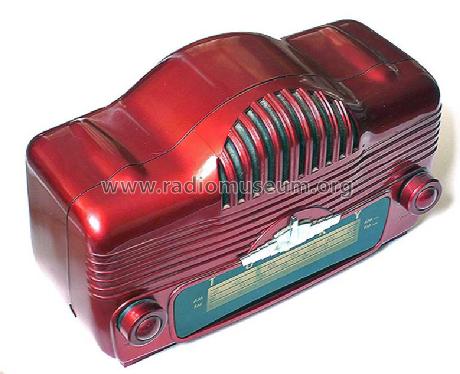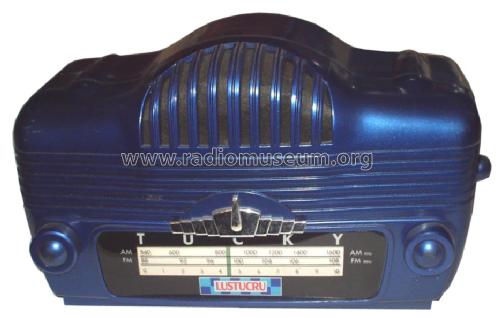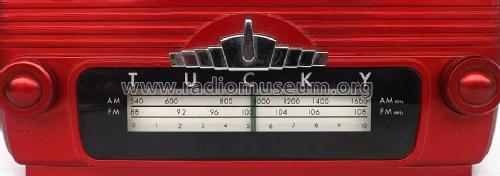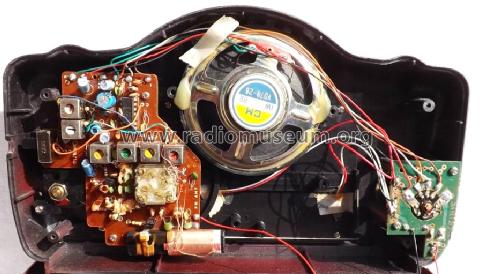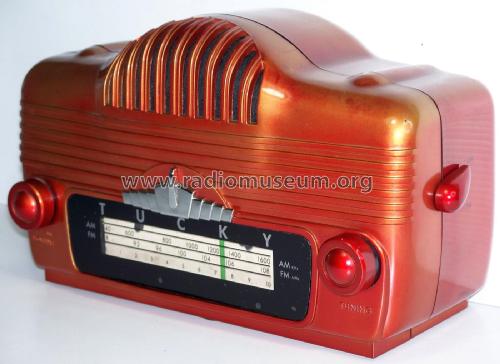Tucky BC and FM
Lexon; Boulogne
- País
- Francia
- Fabricante / Marca
- Lexon; Boulogne
- Año
- 1989 ??
- Categoría
- Radio - o Sintonizador pasado WW2
- Radiomuseum.org ID
- 189227
- Principio principal
- Superheterodino en general
- Gama de ondas
- Bandas de recepción puestas en notas.
- Tensión de funcionamiento
- Pilas / 4 D batteries, 6 Volt
- Altavoz
- Altavoz dinámico (de imán permanente)
- Material
- Plástico moderno (Nunca bakelita o catalina)
- de Radiomuseum.org
- Modelo: Tucky [BC and FM] - Lexon; Boulogne
- Forma
- Sobremesa de tamaño mediano sin botonera <= 35 cm. (Incluso portables pero sólo con alimantación por red).
- Ancho, altura, profundidad
- 240 x 140 x 95 mm / 9.4 x 5.5 x 3.7 inch
- Anotaciones
- This version of Tucky has Braodcast and FM. See also the model with FM and long wave instead of the broadcast band. Retro radio, a remake of: Sonora 301 Exellence/Cadillac, half the size. Lexon probably did not manufacure it but a company in the Far East. They have metallic bright colors, at least six different colors like red, blue, two versions of different silver, violet and green.
There is even a smaller Tucky, which we called "Mini Tucky" for distinction. It is a later retro radio for Sonora France "Excellence 301" (named also "Cadillac"). Lexon probably did not manufacure it but a company in the Far East.
By the way - from Wikipedia: The National Carbon Company introduced the first D cell in 1898. Before smaller cells became more common, D cells were widely known as flashlight batteries. The U.S. military designation for this battery type since before WW II is BA-30. An alkaline D cell is designated by ANSI as "13A" and IEC as "LR20". The "D" designation originated with the first American standards for dry cells. The standard D cell has a length of 60.5±1.0 mm (2.38±0.04 in) and a diameter of 33.1±1.0 mm (1.31±0.04 in). The Capacity varies depending on cell chemistry: Zinc–carbon, Alkaline, Li-FeS2 for 1.5 volts - rechargeable NiCd or NiMH for 1.25 volts. The probably most known batteries are 4.5-Volt, D, C, AA, AAA, 9-Volt and the button cells like SR41/AG3 or SR44/AG13.
A watch battery or button cell is a small single cell battery shaped as a squat cylinder typically 5 to 12 mm in diameter and 1 to 6 mm high—like a button on a garment, hence the name. Some cells larger than the dimensions above are also called button cells, but are less commonly used. Lithium cells are generally similar but somewhat larger; they tend to be called either lithium cells or batteries or coin cells rather than button cells. Depending on the design and chemical compounds used, lithium cells can produce voltages from 1.5 V to about 3.7 V, over twice the voltage of an ordinary zinc-carbon battery or alkaline cell battery. Button cells are single cells, usually disposable primary cells. Common anode materials are zinc or lithium. Common cathode materials are manganese dioxide, silver oxide, carbon monofluoride, cupric oxide or oxygen from the air. Mercuric oxide button cells were formerly common, but are no longer available due to the toxicity and environmental hazard of mercury. Cells have a metal can forming the bottom body, with a circular insulated top cap. The can is the positive and the top the negative terminal. The first letter indicates the chemical composition like L for Alkaline, S Silver, P Zinc-air, C Lithium, B Carbon monofluorid and G Copper oxide. The first 3 have Alkali as electrolyte, the last 3 organic electrolyte. M and N for Mercuric oxide are withdrwawn.
- Autor
- Modelo creado por Ernst Erb. Ver en "Modificar Ficha" los participantes posteriores.
- Otros modelos
-
Donde encontrará 12 modelos, 11 con imágenes y 0 con esquemas.
Ir al listado general de Lexon; Boulogne
Colecciones
El modelo Tucky es parte de las colecciones de los siguientes miembros.
